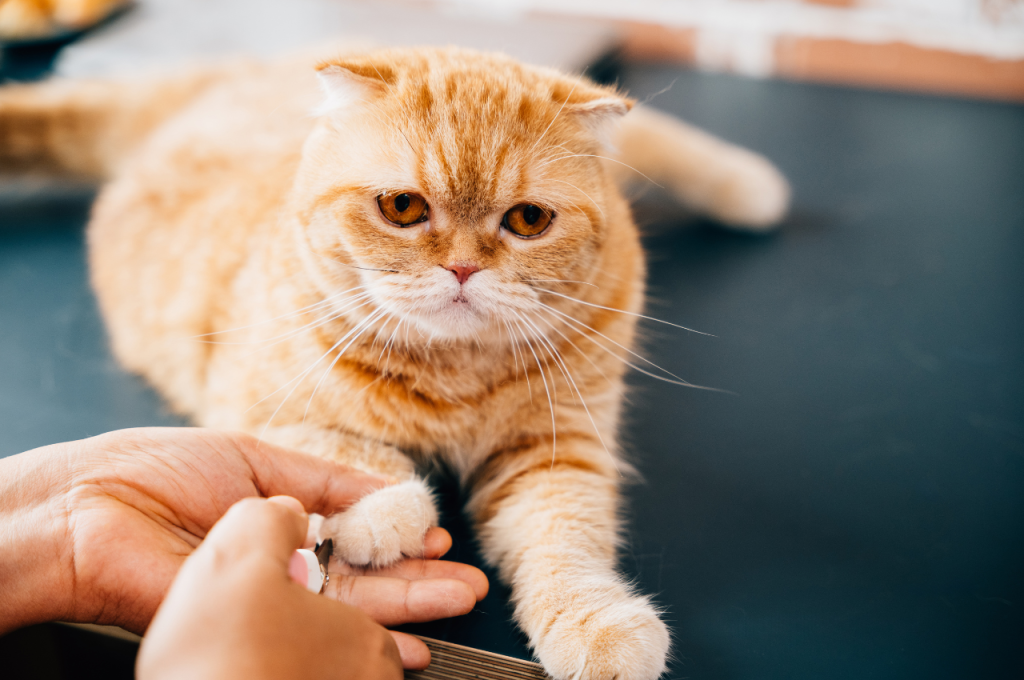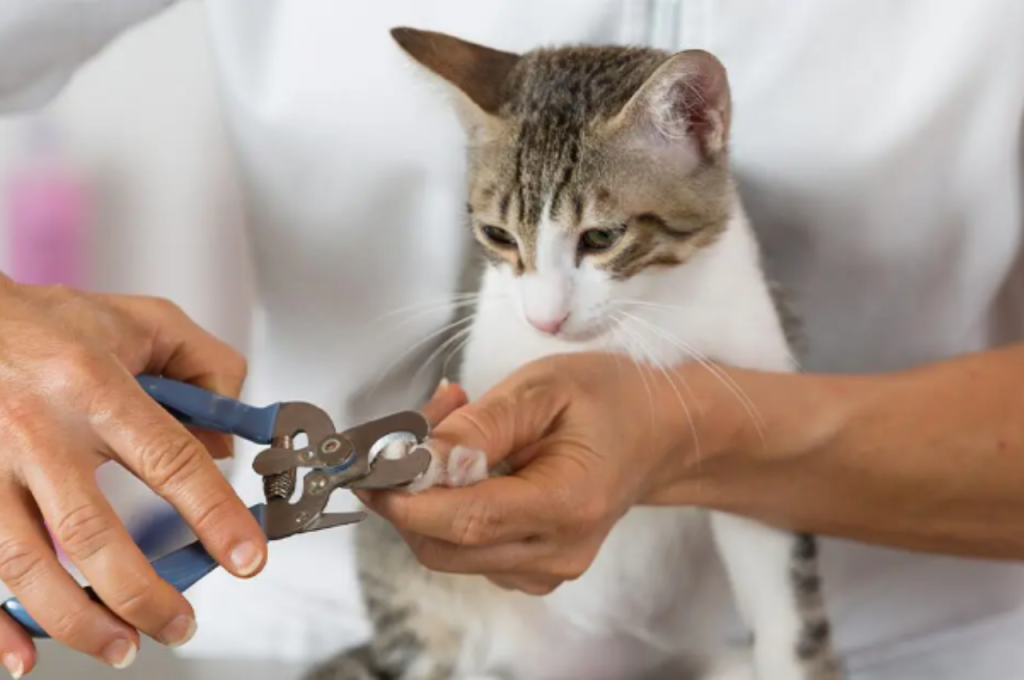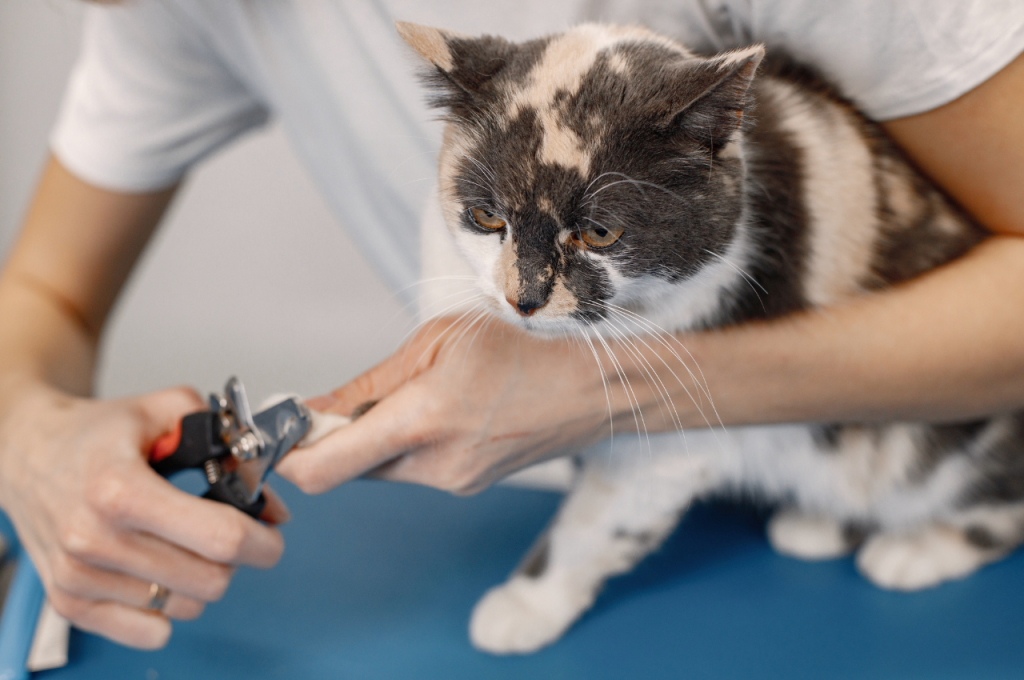To trim cat nails, first, use proper nail clippers designed for cats. Gently hold the paw and clip off the tip of the nail, avoiding the pink part, which contains the blood vessels.
Regularly trimming your cat’s nails is an essential part of their grooming routine. Though it is not the most pleasant task, it prevents the nails from becoming too long and causing discomfort or injury to your furry friend. Not only that, but it also saves your furniture and clothing from being scratched and ruined.
However, improper trimming can result in pain and bleeding in your cat’s paws. This guide will provide you with the necessary steps to correctly and safely trim your cat’s nails without causing any harm.
Why Cat Nail Trimming is Important
Regularly trimming your cat’s nails is crucial for their health and safety. Long nails can cause discomfort, pain, and even infection, while trimmed nails promote healthy foot posture. Follow some basic guidelines to safely trim your cat’s nails at home.

Cat nail trimming is an essential grooming task that every cat owner should regularly perform. Keeping your cat’s nails trimmed not only helps to maintain their overall health but also prevents damage to your furniture and other belongings. Additionally, regular nail trimming can prevent your cat from scratching humans or other pets in their household. In this post, we will discuss the importance of cat nail trimming and how to do it properly.
Prevent Furniture Damage
Cats love to scratch, and if you don’t provide them with an acceptable place to scratch, they will find something else to use, such as your furniture or carpet. By keeping your cat’s nails trimmed, you reduce the damage they can do to your belongings. Regular nail trims encourage your cat to use their scratching post, preventing them from snatching your sofa or chairs.
Avoid Scratches on Humans
Cats are known to scratch humans, sometimes causing painful and unpleasant wounds. Keeping your cat’s nails trimmed will limit their ability to scratch you, your kids, or other pets in the house. When their nails are sharp, cats can unintentionally harm others during playtime or when they feel scared or threatened. Regular grooming will help prevent any accidental scratches.
Prevent Ingrown Nails
Overgrown nails can also cause ingrown nails, a painful condition that occurs when the nail curls back into the paw pad. You can prevent this by trimming your cat’s nails regularly. If you notice your cat limping or favoring one paw, it’s essential to check their nails for any ingrown nails. Regular nail trimming avoids this painful condition and ensures your pet stays healthy.
Tools You Need
Trimming your cat’s nails is an essential part of their grooming routine to keep their claws from becoming too long or sharp. It’s important to have the right tools on hand to make this process easier for both you and your cat. Here are the essential tools you’ll need:
Cat Nail Clippers
The first tool you’ll need is a good pair of cat nail clippers, which are specifically designed to trim a cat’s claws. You can choose between scissors or guillotine-style clippers, whichever you find easiest to handle.
Styptic Powder
Even the most experienced cat owner can accidentally cut the quick, pink part of the nail that contains blood vessels and nerves while trimming their cat’s nails. To stop any bleeding, styptic powder is essential. This powder is a lifesaver that helps clot the blood and prevent further bleeding.
Treats
Cat nail trimming can be stressful for your feline friend, so having plenty of tasty treats on hand as a reward for good behavior is essential. You can also use treats as a distraction while trimming their nails, so they don’t notice what’s happening.
Now that you have all the tools necessary, it’s time to get started on the trimming process. Remember to be gentle, go slowly, and take breaks when needed to ensure a successful trimming session.
Step-by-step Instructions
As a cat owner, it is essential to know how to trim your cat’s nails to avoid injury to your furry friend and yourself. It’s not uncommon for pet owners to dread the thought of trimming their cat’s nails, but it’s a necessary task that can be done easily with the right tools and some practice. In this article, we’ll provide you with step-by-step instructions on how to trim your cat’s nails. Let’s begin!
Pick the Right Time
Cats are sensitive creatures and require a calm and relaxed environment to trim their nails. Choose a time when your cat is relaxed, such as after a meal or a play session. Ensure that you have enough time to complete all the nails without feeling rushed or stressed. It’s important to note that if your cat is exhibiting any signs of stress or discomfort, it’s best to stop the process and try again later.
Introduce Clippers to Cat
Before you start trimming your cat’s nails, it’s important to introduce them to the clippers. Allow your cat to sniff the clippers and touch them with their paws. This will help them get used to the clippers and build a level of comfort. Once they are comfortable, hold the clippers in your hand and gently touch your cat’s paw with them. Practice this several times before attempting to trim their nails.

Find Quick and Cut
The “quick” is the blood vessel that runs through the nail. It’s important to identify the quickest and avoid it when trimming your cat’s nails because it can cause discomfort and bleeding. If your cat has light-colored nails, the quick will be visible as a pinkish area. If your cat has dark-colored nails, you may need to use a flashlight to identify them quickly. Once you have identified the quick, use sharp clippers to cut the tip of the nail, avoiding the quick.
| Do’s | Don’ts |
| Use sharp clippersHold the paw gently but firmlyTrim a little bit at a time | Trim in the darkRush the processForce your cat to comply |
Use the Styptic Powder
Accidents can happen, and it’s common to cut the quick when trimming your cat’s nails. Using styptic powder can help stop the bleeding and prevent infection. Simply dip the bleeding nail into the styptic powder, and apply gentle pressure to the area. If bleeding persists, seek veterinary care.
Trimming your cat’s nails may seem daunting at first, but with practice and patience, it can become a routine task that you and your cat can handle with ease. Remember to always use the right tools, identify the quickest, and provide a calm and relaxed environment for your furry friend.
Tips and Tricks
Keep your cat’s nails trimmed to prevent painful scratching. Use proper nail clippers and avoid cutting into the quick, which can cause bleeding and discomfort. Gradually introduce your cat to nail trimming and offer treats for positive reinforcement.
Cats are adorable creatures, and trimming their nails is something you should do regularly. It will help prevent any damage to furniture, people, or other pets. But how do you do it without getting a scratch? Below are some tips and tricks to help you:
Get Helper to Assist
It is always better to have someone help you when trimming your cat’s nails, especially if you are doing it for the first time. This person should be a trusted individual who can hold your cat in place while you work on trimming the nails. You can also ask them to distract your cat with toys or treats while you are cutting the nails.
Use A Scratching Post
One useful tip is to use a scratching post to help you. A cat will feel more comfortable and relaxed when they are in their usual scratching position. Place the scratching post in a comfortable and well-lit area. Gently place your cat on the post and begin by touching their claws and nails to get them comfortable with the process. Then, slowly introduce the nail clippers to their paws.
Practice
Trimming your cat’s nails takes some practice, so don’t be discouraged if it doesn’t go well the first time. Start by trimming one nail at a time and then rewarding your cat with a treat or cuddle. Repeat the process until all the nails are trimmed. Over time, your cat will become accustomed, and the process will be easier.
Common Mistakes to Avoid
To properly trim your cat’s nails, refrain from cutting the quick (the pink part of the nail) and avoid trimming too much at once. It’s also important to have the right tools and to remain calm and patient during the process.
Cats are known for their independent nature, but even the most aloof of felines need their nails trimmed from time to time. However, cutting a cat’s nails can be a daunting task, especially for new cat owners. To make the process easier, it’s important to avoid common mistakes. Here are a few common mistakes to avoid when trimming your cat’s nails.
Cutting Nails Too Short
One of the biggest mistakes cat owners make when trimming their cat’s nails is cutting them too short. Cutting the nails too short can cause pain and discomfort for the cat, leading to bleeding and infection. To avoid this, only cut the tip of the nail, where it starts to curve. If you’re unsure how much to cut, take it slow and cut small pieces at a time.
Not Being Prepared
Another common mistake cat owners make is not being prepared before starting the trimming process. Make sure you have all the necessary tools, including nail clippers and styptic powder to stop bleeding in case you accidentally cut the nail too short. It’s also a good idea to have someone else hold the cat still while you trim their nails, especially if your cat is a bit skittish.
Being Rough with Your Cat
Finally, it’s important to avoid being rough with your cat during the nail-trimming process. Cats can become agitated or scared, and if you’re rough with them, they may become aggressive or retreat and hide. Instead, use a gentle touch when trimming their nails, holding their paws gently but securely and using calm, soothing tones. Remember, trimming your cat’s nails doesn’t have to be a stressful experience for either you or your cat. By avoiding these common mistakes and taking a gentle approach, you can make the process quicker and easier for everyone involved.
When to Seek Help
Trimming your cat’s nails can be challenging, but is necessary for their health and safety. Seek help from a veterinarian or professional groomer if you are uncomfortable or unable to do it properly on your own.

When it comes to grooming your cat, trimming their nails is an important task. However, there may be times when you need to seek professional help. Here are some situations where it’s best to seek help:
The cat has Black Nails
If your cat has black nails, it can be difficult to see the quick – the pink area that contains blood vessels and nerves. If you accidentally cut the quick, it can be painful and cause bleeding. In this case, seek help from a veterinarian or professional groomer who can trim your cat’s nails safely.
Cat Is Resistant to Nail Trimming
If your cat is not cooperative during nail trimming and becomes aggressive or anxious, it’s best to seek help from a professional. They have experience in handling cats and may use calming techniques or tools to ease your cat’s anxiety.
Cat’s Nails are Overgrown
If your cat’s nails are overgrown and curling, it can cause discomfort and potential injury to their paws. In this case, a professional groomer or veterinarian can safely trim your cat’s nails and guide how to maintain them in the future. It’s important to prioritize your cat’s safety and well-being when it comes to nail trimming. Seeking professional help in these situations ensures that the process is done safely and effectively.
Frequently Asked Questions of How to Trim Cat Nails
Certainly! Here are some frequently asked questions about how to trim cat nails:
1. Is it necessary to trim a cat’s claws?
Yes, it is necessary to trim a cat’s claws regularly. Trimming their claws helps to prevent them from getting too long and causing damage to furniture or injuring people or other animals. It also helps to keep a cat’s paws healthy and reduces the risk of infection.
2. How can I cut my cat’s nails at home?
To cut your cat’s nails at home, you’ll need a pair of sharp, cat-specific clippers. Start by gently holding your cat’s paw and trimming just the tip of each nail. Avoid cutting the quick, pink part of the nail that contains blood vessels, as it can be painful.
Reward your cat with treats and praise throughout the process to keep them calm and happy.
3. Is nil trimming painful for cats?
Cats may experience some discomfort when their nails are trimmed, but it should not be painful. It is important to use proper tools and techniques and to approach the process patiently to minimize any discomfort. Regular nail trimming can also help prevent more serious health issues.
Conclusion
Effective cat nail trimming requires patience, practice, and the right tools. Regular trimming can prevent painful scratches and injuries to both cats and owners. Remember to remain calm, offer praise and treats, and never punish your cat during the process.
With these tips and techniques, both you and your feline friend can have a stress-free grooming experience.
Happy trimming!
